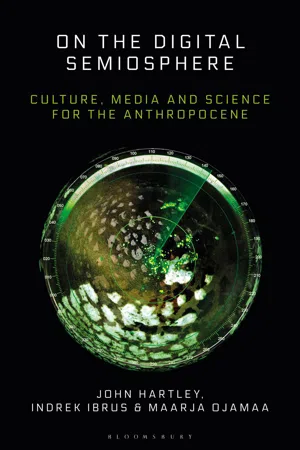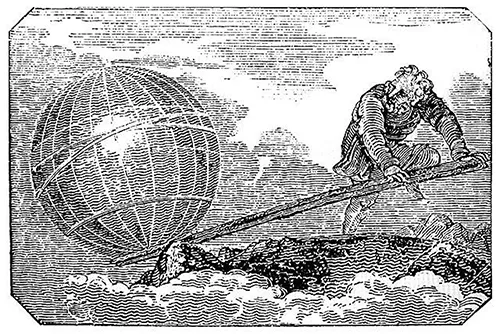![]()
PART ONE
Spheres and globes
Peeter Laurits ‘Plant Pride’ (2018) from Coming Soon
https://www.peeterlaurits.com/works/coming-soon
![]()
1
A semiotic theory of spheres
The relationship between multiplicity and unity is a fundamental characteristic of culture. It is here that logical and historical reality diverge.
(JURI LOTMAN, 2009: 3)
***
One world; one species
In 2016, on the eve of the Trump presidency in the United States, the architect and commentator Michael Sorkin published an opinion-column about the practice of architecture in the era of Trump Towers:
Ours is not an autonomous discipline operating in a free field. Rather, it’s ever engaged in a deepening struggle to find the terms of its own distinction and necessity, especially now, as the designed environment expands its remit to cover the whole world, and the gap between the body and technology grows increasingly blurry. Building always marks and measures space, equity, and possibility, but it’s losing any clear-enough idea of how to perform as we race toward total urbanization on a planet at the point of asphyxiation.
(Sorkin, 2016)
In the same column, Sorkin mentions that he has had to cut short a visit to China because ‘my asthma got so bad I have to come home early’. In March 2020, not in China but in New York City, he was killed by the global viral contagion of COVID-19.1 His words take on a portentous prescience:
Civilizations are marked by their priorities, and ours are too given over to prisons, malls, and McMansions and too little to good housing for all, complete and sustainable communities, green energy, rational mobility, structures of succor. Politics programs our architecture. The emblem of Trump’s agenda is a piece of architecture – that absurd pharaonic wall he bruits for the Mexican border. His whole project trumpets control, and his mantra is shared by many an architect: just leave it to me!
(Sorkin, 2016)
Architecture is but one of many creative knowledge-based disciplines that is forced to rethink its purposes and principles in response to the globalizing dynamics of digital media, led by free-market corporate expansionism and libertarian ideologies (‘just leave it to me!’). In practice, these seem to produce only their own opposite: authoritarianism and surveillance:
Trump’s sensibility is deeply old-fashioned: he makes buildings, things. Far scarier than tacky, grandiose building, however, is a spatial agenda being advanced by famously liberal Silicon Valley: the ‘smart’ city. The phrase creeps me out. I worry that we’re being sold a bill of goods by huge corporations looking to embed sensors in every sidewalk, window, and wall to create ‘responsive’ environments in the name of unsnarling traffic, conserving energy, and keeping megacities going, but which will be used, at best, to continue compiling consumer and behavioral profiles to sell us stuff – and, at worst, to surveille every inch of the earth to call down drone strikes on designated miscreants or raids by ICE on those 11 million ‘illegals,’ based on some biometric fantasy of alien-ness. Data are not neutral. Metadata can be the devil’s work.
(Sorkin, 2016)
These are the issues motivating this book. It seems that humans only become aware of themselves as a single, global species when faced by a singular, globular threat. It used to be nuclear catastrophe; in the last few years, it’s been global warming; now it’s coronavirus. The response, however, is far from global. So far, it’s nationalistic, partisan, self-interested and oftentimes stupid. It’s the same as it has been since Neolithic times: ‘This means war!’
That means death for some, while others prosper, careless of collateral damage while pursuing ‘business as usual’. Sorkin himself was an early casualty. But his message need not be. Instead of continuing ‘business as usual’ by digital means, those who practice the knowledge professions, where digital globalization is most accelerated, need to work harder to understand why a liberal-sounding business agenda can result in a dystopian disaster for unfavoured individuals and for the planet as a whole. As Sorkin argues, those who observe and engage in the globalization of digital media and culture need to consider the terms of their own ‘distinction and necessity’. What value has each successive technological trend (from Parametricism in architecture to Blockchain in trade) if its users simply apply it to political parochialism and careless profit? Too often these bring with them no sense of shared responsibility for the species or the planet, but only deeper divisions between ‘winners’ and ‘losers’ (as US president Trump likes to put it).
Are ‘we’ sleepwalking into pandemics and climate catastrophe, or can we take collective action to achieve ‘structures of succor’ for individual selves, for social communities and the Earth system? That’s the agenda for youth-led climate justice action ‘on the street’ (real and virtual). It’s also the agenda for this book. However, we take a step back from immediate activism in the global ‘designed environment’ of the ‘smart city’ to analyse how culture – built and mediated – ‘always marks and measures space, equity, and possibility’, as Michael Sorkin put it, at micro- and macro-scale, no matter what new technological wonder is deployed to build it.
Can a human-designed planetary environment be both culturally humane and environmentally sustainable? It seems that the answer depends on two things:
– Cui bono? At the outset, who is assumed to be the beneficiary? Is this action for ‘me’ individual, ‘we’ corporate/state agency, or ‘we’ community/humanity?
– Who clears up? At the end, how is the planet assumed to recover from our destructive wastefulness, digital as well as analogue? Are our actions organized for environmental laissez-faire (conquest and exploitation), or systemic regeneration (one species; one planet)?
At the outset, for reasons we hope will become clear throughout, we assume the primacy of culture. In the end, we theorize a ‘digital semiosphere’, whose positive and negative heuristics need to be understood among differing intersectional knowledge systems.
‘Civilisations are marked by their priorities’, says Sorkin. To identify them, we need to return to first principles. This is our plan. You won’t read much more below about the global pandemic, except to acknowledge that ‘going viral’ is a reality we ignore at our peril.
Digital Lotman?
This book is offered as an original work that explains how communication, media and cultural studies, now and in future, can benefit from Juri Lotman’s sophisticated and prescient thinking, which models a systems/dynamic approach to culture as a whole. Building out from that model gives us something to think with, an Archimedes lever (Figure 1.1), not to ‘move the world’ but to subject globalization in the digital era to a positioned ‘outside’ perspective from which it can better be understood and measured. The systems approach that Lotman elaborated has a long history, going back more than a century. At the same time it poses radical new questions about the relationships among humanity, other living beings and the planet.
FIGURE 1.1 Archimedes’ lever moves the world. illustration from Mechanics Magazine, 1824.2
Our notion of the ‘digital semiosphere’ offers a rich and compelling framework for global digital culture and its political, economic and environmental context, at a time when popular media and local activism are increasingly focused on the unfolding climate emergency of the Anthropocene era (on this contested term, see Colebrook and Weinstein, 2015; Schneiderman, 2015; Grusin, 2017; Sperling, 2019). We situate our approach in the intersectional history of ideas but leverage the account towards a new interdisciplinary alignment that is capable of analysing both intimate personal sense-making and global ‘big data’. We show how they’re connected and what governs change. The book is in the Lotmanian tradition (see Chapter 3), which itself was drawn from cybernetics as well as literary theory and the semiotics of culture. But this is a future-facing account, helping readers and interdisciplinary researchers to work from an integrated, systemic-dynamic conceptualization of different levels of semiosis and their modes of interaction. Thereby, cultural and media analysis can step forward with well-theorized explanatory adequacy, at a time when too much scholarship is narrowly focused, encouraging local specialization with technical detail amid a chaos of incommensurate methods, or unwittingly applying formulae derived from the spent paradigm of industrial, analogue, nation-state theorizing.
A word or two about ‘digital’. The semiosphere has of course existed for centuries, and its workings have co-evolved with technologies of communication, ever since humans gained the power of speech. Human exploration and migration have accelerated throughout modernity (as we explain in Chapter 2), so that ‘the global’ has been understood to refer to the planetary Earth system since at least the 1500s. There is a very strong element of continuity about the ‘digital semiosphere’. But we argue too that here is a step-change, irreversible and ‘explosive’ in Lotman’s terms (2009). The shift (colonialism, goods, industry and trade) → (corporate globalization of information, computation and mediated communication) is revolutionizing the world economy, its politics and our knowledge systems, at an accelerating rate (McKinsey, 2016), with consequences going far beyond commerce and trade, provoking a new focus on the fundamentals of care, culture and community, and their prospects in a post-coronavirus world.
By ‘digital’ we mean the constellation of phenomena that now dominate the information or knowledge society, where converged and integrated electronics, telecommunications, broadcasting, computation, the internet, automation and artificial intelligence drive the military, the economy, politics and mediated culture at personal, corporate and international scale.
‘Globalization’ may not have reached all countries or industries and may still exclude the ‘global poor’, but digital automation may still determine how those groups are known and treated. The Guardian reported in 2019:
All around the world, from small-town Illinois in the US to Rochdale in England, from Perth, Australia, to Dumka in northern India, a revolution is under way in how governments treat the poor. You can’t see it happening, and may have heard nothing about it. It’s being planned by engineers and coders behind closed doors, in secure government locations far from public view. Only mathematicians and computer scientists fully understand the sea change, powered as it is by artificial intelligence (AI), predictive algorithms, risk modeling and biometrics. But if you are one of the millions of vulnerable people at the receiving end of the radical reshaping of welfare benefits, you know it is real and that its consequences can be serious – even deadly.3
Although digital globalization may not include everyone, it certainly governs and regulates our life chances and everyone else’s. Together with what Jackie Wang (2018) calls ‘carceral capitalism’, the planet is entering a new phase where digital information, productivity and culture can generate untold wealth for some but unimagined ‘digital dystopia’ for others, under a creeping regime of digital surveillance and the militarization of policing, much of it done by corporations and partisans (Wang, 2018), backed up by ‘disinformation war’ in marketing and social media (Coppins, 2020).
Digital labour involves unpaid employment. It used to be called slavery but now goes by other names, from indebted bondage and prison labour to ‘internships’, ‘influencers’ and ‘volunteer’ work. Automation generates AI-driven uselessness among the unskilled (Harari, 2018): with a ‘reserve army’ of precarious, displaced and migrant labour ‘outsourced’ to low-GDP regions (Foster, McChesney and Jonna, 2011).
It is not just natural resources (Lampert, 2019) but also human resources that are exploited and wasted at unprecedented scale and with little accountability. Those who enjoy affluence and those who endure poverty never meet. While private wealth inequality increases, governments are poor and indebted, and public investments in poverty-reduction decrease (Alvaredo et al., 2018: 11–15).
It would be foolish to think that scholarship or even action can halt these trends simply by contesting them, although documenting the erosion of public and democratic acts, institutions and relationships is vital work. It would be far more foolish not to try to understand them. That is why we think the concept and study of the ‘digital semiosphere’ is of the utmost importance right now.
This is where Lotman comes in (Figure 1.2). Although communication, media and cultural studies have separately and collectively developed a distinctive object and mode of study since the 1970s, this vibrant and interdisciplinary field has borrowed more than it has returned to neighbouring fields. Economics, political, technological and social sciences all expect to influence the world, but they don’t take serious account of culture and semiosis – which nevertheless (we argue) make the world go round. Lotman ...


